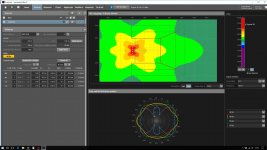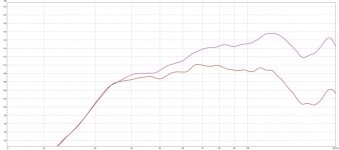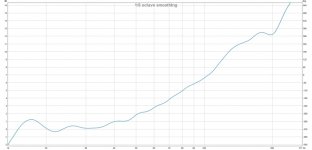Hi Zwiller,
On the second handed market you can find a Presonus GTX44 for around 175 €
Regards,
Djim
On the second handed market you can find a Presonus GTX44 for around 175 €
Regards,
Djim
Not wrong, but I would not classify the TH-18 as a cardioid source without seeing a proper polar plot proving it is.i what i ment is having a horizontal "column" with omnidirectional sources must cause different lobes compared to a column with cardioid sources. am i wrong?
I have measured my Keystone TH, a FLH and a BR under the same conditions, the upper response (above 80 Hz IIRC) of the TH and FLH were a bit more narrow than the BR, but not approaching what I would call "cardioid".
1) The phase response of a specific microphone could be emulated in a loudspeaker with FIR filters, but the latency the filter would create would render that a useless pursuit. In the "real world" of live reinforcement, the phase response of the system bears little resemblance to the phase response of the microphones used.1)Just clarifying, phase of the mics is a non issue due to TH or fixed via digital XO?
2)In my mind the signal is delayed but mics could still be out of phase with each other?
3)That said, this is coming mostly from a recording mindset.
4)Bertl, curiosity got to the best of me since a gates like Art mentioned were serious bucks back when I ran a large rig and started looking for frequency dependent gates and I happened to stumble upon a post of Art's on another forum recommending the Behringer quad gate. Dirt cheap here. Hopefully same for you.
2) Different types of microphones have different phase response, for instance dynamic microphone phase response lags compared to condenser mics.
Although there is an AES directive that a positive waveform should result in a positive output on pin two and negative on pin three, there are plenty of exceptions and legacy products (microphones, DI boxes, processers, etc.) wired in reverse polarity to that standard.
3) Studio recording mics are often used at relatively far distance from the source, while getting enough gain before feedback for loud live reinforcement requires extreme close micing, the inverse distance law rendering phase or polarity differences between mics nearly an academic point.
4) Considering analog consoles and outboard gear have largely been replaced with inexpensive digital counterparts like Bertl uses, one can now easily afford a frequency dependent noise gate on any and every channel. I find it interesting that there are sound people now that have never mixed on an analog console!
Art
First the phasing/polarity story of course can happen but in my special case this can be simply forgotten because the kickdrum mic was the one and only mic which was open on the pa when biginning the sound check (i belong with the majority of sound techs which do it that way -probably you too).
I see no reason to use any analog behringer gear even if its cheap but thanx for the tip. About twenty years ago i had a short but intensive 3-year lasting periode as a professional FOH tech (yes, i really earned money for that😀). I used mainly Soundcraft or DDA consoles with outboard equipment. At this time everything was turning around to push the voices out of the boxes. So having compressors like dbx or drawmer gates was really fine. The eventide harmonizer was the non-plus-ultra. Then my wife came over me.....nothing more to say.
Today, after years in other jobs ,i'm a hobby-tech and i'm using the affordable X32 (which is really approved i think). Maybe im upgrading to the M32 or switching to GLD80. So i'm "re-learning" the business now.....
Weltersys
You're right, a real cardioid behavior in the 50Hz region is truly hard to get from a relatively small box even if its a horn. To get a polar pattern plot would be really fine because in my personal audition the THs are playing far more directional than br subs
I see no reason to use any analog behringer gear even if its cheap but thanx for the tip. About twenty years ago i had a short but intensive 3-year lasting periode as a professional FOH tech (yes, i really earned money for that😀). I used mainly Soundcraft or DDA consoles with outboard equipment. At this time everything was turning around to push the voices out of the boxes. So having compressors like dbx or drawmer gates was really fine. The eventide harmonizer was the non-plus-ultra. Then my wife came over me.....nothing more to say.
Today, after years in other jobs ,i'm a hobby-tech and i'm using the affordable X32 (which is really approved i think). Maybe im upgrading to the M32 or switching to GLD80. So i'm "re-learning" the business now.....
Weltersys
You're right, a real cardioid behavior in the 50Hz region is truly hard to get from a relatively small box even if its a horn. To get a polar pattern plot would be really fine because in my personal audition the THs are playing far more directional than br subs
thats why i stick on the idea THs would be "cardioid" sources
Lambda Labs | professional acoustics
a pack of 2 TH18s close together should behave similar i think.....
Lambda Labs | professional acoustics
a pack of 2 TH18s close together should behave similar i think.....
I would expect the tapped horn subs to be fairly ommidirectional.
Far more important would be the spacing and delays used.
I was looking for some software to help calculate optimal delays and found arraycalc on the D&B Audiotechnik site.
Simulation - Software | d&b audiotechnik
It says that its only meant for use with D&B speakers but if you choose an ommidirectional sub from the range and enter the number of speaker pairs & spacing you used the results look like they could be useful!
Far more important would be the spacing and delays used.
I was looking for some software to help calculate optimal delays and found arraycalc on the D&B Audiotechnik site.
Simulation - Software | d&b audiotechnik
It says that its only meant for use with D&B speakers but if you choose an ommidirectional sub from the range and enter the number of speaker pairs & spacing you used the results look like they could be useful!
Attachments
I measured my 2 FLH's (58cm wide, 75cm deep, 116cm high each) both in front and back side. 3M from the mouths. As the lines didn't line up <20Hz, and i highly doubt there is any directivity down there, I added 2,9dB to the 180deg line.
Both in 1/12th octave smoothing, difference between the plots with 1/6th octave smoothing
I don't believe 3M is a good distance to do these kind of measurements, so I will repeat them soon at 10M or maybe more...
As you can see there is a small amount of directivity. So yes, this is cardioide, as any reduction in rear output would qualify as cardioide. But every sub does this to some degree, related to size.
Both in 1/12th octave smoothing, difference between the plots with 1/6th octave smoothing
I don't believe 3M is a good distance to do these kind of measurements, so I will repeat them soon at 10M or maybe more...
As you can see there is a small amount of directivity. So yes, this is cardioide, as any reduction in rear output would qualify as cardioide. But every sub does this to some degree, related to size.
Attachments
good news! 2-3dB damping at the backside can be a helpfull thing even when damping is frequency dependend. having 1 sub there is no big egfect but if you have 3 or 4 subs per side it matters. just think about reflections from backwall or lower levels on stage. i will try also to measure this.
xoc1, meanwhile im shure the setup we made on this last event was rubbish. correct distances between the boxes are very important when having a line. thank you for the link to arraycalc. this is what i'm lookung for. i will check this.
of course manufacturers support their own products. i think this is not only marketing stuff. i'ts because these minimal deviations, like carneolon was able to measure, have significant effects to the overall result. to get a proper calculation of a large array the directional behavior of the single boxes must basicly be known exactly.
xoc1, meanwhile im shure the setup we made on this last event was rubbish. correct distances between the boxes are very important when having a line. thank you for the link to arraycalc. this is what i'm lookung for. i will check this.
of course manufacturers support their own products. i think this is not only marketing stuff. i'ts because these minimal deviations, like carneolon was able to measure, have significant effects to the overall result. to get a proper calculation of a large array the directional behavior of the single boxes must basicly be known exactly.
Standing 10 meters in front of a 3x3 stack xoc1 th18's, or at the back 10 meters is a difference between hell and heaven.
hahaha! next weekend I can do some measurements with 12x xoc1. probably not at war volume because of restrictions.
#377
Pabesco is offline Pabesco Bahamas
diyAudio Member
Join Date: Jul 2013
Good day to all. Just a quick question.
Has anyone used two of these th18s along with two
Othorns
I have this combination and will tone them differently crossover wise but would like to know
If I would need to delay the othorns due to the longer path in the horn. Thank you for any info any of you can give.
Pabesco is offline Pabesco Bahamas
diyAudio Member
Join Date: Jul 2013
Good day to all. Just a quick question.
Has anyone used two of these th18s along with two
Othorns
I have this combination and will tone them differently crossover wise but would like to know
If I would need to delay the othorns due to the longer path in the horn. Thank you for any info any of you can give.
Pabesco,#377
Pabesco is offline Pabesco Bahamas
diyAudio Member
Join Date: Jul 2013
Good day to all. Just a quick question.
Has anyone used two of these th18s along with two
Othorns
I have this combination and will tone them differently crossover wise but would like to know
If I would need to delay the othorns due to the longer path in the horn. Thank you for any info any of you can give.
The Othorn, being about a meter longer than the TH-18 , would use no delay, the TH-18 would use roughly 3 ms more delay than usual, the mains delayed to match the roughly 3.48 meter path length of the Othorn, assuming the mouths of both horns are set at the same distance from the "money seats".
Art
Thank you for the info. And the correction as to which one needs to be delayed. My mistake. Also I would assume that the mains would need approximately 9.5ms delay. Also
I know it would need a bit of tweeting from around that point.
If I'm incorrect please let me know.
Thanks art.
I know it would need a bit of tweeting from around that point.
If I'm incorrect please let me know.
Thanks art.
Pabesco,Thank you for the info. And the correction as to which one needs to be delayed. My mistake. Also I would assume that the mains would need approximately 9.5ms delay. Also
I know it would need a bit of tweeting from around that point.
If I'm incorrect please let me know.
Thanks art.
"Tweeting" is for birds and idiot presidents ;^).
"Tweaking" the 9.5 ms delay would be in order, depending on the phase response of your top cabinets and the filters you use, as the path length difference can't be assumed to be the correct delay.
A "bass reflex" cabinet is also known as a "phase inversion" cabinet, the LF response lags from the upper response by a wavelength at Fb, so depending on the Fb and design (horn, sealed, ported) of the upper cabinet the path length difference is only a starting point.
It used to be so much easier before awareness set in...
Cheers,
Art
Attachments
Last edited:
Lol. You are so correct about tweeting. Thank you the correction and for the information. I understood most of what you said and some I still have to be educated on.
I'm not too sure what you mean about the filters I use. Are you referring to EQ settings? Or are there other filters I should be aware of.
I thank you all in advance for the much needed education
I'm not too sure what you mean about the filters I use. Are you referring to EQ settings? Or are there other filters I should be aware of.
I thank you all in advance for the much needed education
"Tweeting" is for birds and idiot presidents ;^).
Cheers,
Art
Rotflmao!
"Filters" are simply another term for HP, LP, or PEQ (parametric equalization), each of which contributes a phase change of 90 degrees per "pole" or "order" (in a classic filter a "pole" is either a capacitor or an inductor), which in turn may require an adjustment to delay settings- a 6 dB (single pole) per octave filter has 90 degrees of phase shift, a 24 dB per octave (four pole) filter has 360 degrees of phase shift- the numbers add up to time.I'm not too sure what you mean about the filters I use. Are you referring to EQ settings? Or are there other filters I should be aware of.
I thank you all in advance for the much needed education
And time is money, must to get back to productivity now...
Art
Thank you once again Art. I'll get around to experimenting with this and learning a bit more
Next week. Thank you guys so much for the info given. I have to get back to preparing for this massive hurricane that looks like it's coming my way. I live in the Bahamas and this is stated to be the most powerful hurricane ever recorded with winds at 185 mph. May The Almighty be with us all.
Next week. Thank you guys so much for the info given. I have to get back to preparing for this massive hurricane that looks like it's coming my way. I live in the Bahamas and this is stated to be the most powerful hurricane ever recorded with winds at 185 mph. May The Almighty be with us all.
- Home
- Loudspeakers
- Subwoofers
- TH-18 Flat to 35hz! (Xoc1's design)



